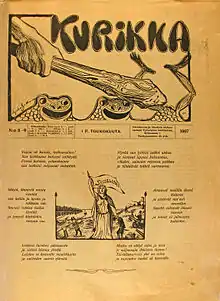 Cover page dated 1907 | |
| Categories | Satirical magazine |
|---|---|
| Founded | 1904 |
| Final issue | 1954 |
| Country | Finland |
| Based in | Helsinki |
| Language | Finnish |
Kurikka was a Finnish language socialist publication headquartered in Helsinki, Finland. It was started as a labor newspaper in 1904, but then was relaunched as an illustrated satirical magazine which was in circulation until 1954.
History and profile
Kurikka was founded as a newspaper in Helsinki in 1904.[1][2] It was affiliated with labor movement.[1][3] Soon after its start it was redesigned as an illustrated satirical magazine.[1]
Although it had a socialist stance, its cartoonists also included non-socialist figures, including Eric Vasström and Hjalmar Löfvin.[1] The magazine employed the Old Helsinki slang in the satirical materials.[4] Kurikka was blamed by its opponents for targeting the bourgeoisie.[5] However, before the civil war in Finland in 1918 the magazine declared its enemies as bourgeoisie, capitalists and gentlemen.[5] At the end of the civil war the magazine's affiliation changed in that Kurikka became closer to the Social Democratic Party in 1923 due to the split in the labor movement.[5]
Kurikka enjoyed higher levels of circulation in the 1920s and 1930s.[5] Although its competitors Fyren and Tuulispää sold only 3,000–4,000 copies, Kurikka managed to sell 20,000 copies.[5] The magazine ceased publication in 1954.[1]
References
- 1 2 3 4 5 Ainur Elmgren (2020). "Visual Stereotypes of Tatars in the Finnish Press from the 1890s to the 1910s". Studia Orientalia Electronica. 8 (2): 27. doi:10.23993/store.82942. hdl:10138/333286. S2CID 219422535.
- ↑ Mia Korpiola (2022). "Lawyers providing Legal Aid in Print: Legal Question and Answer Columns in Finnish Newspapers around 1900". In Felice Batlan; Marianne Vasara-Aaltonen (eds.). Histories of Legal Aid: A Comparative and International Perspective. Cham: Palgrave Macmillan. p. 197. ISBN 978-3-030-80271-4.
- ↑ Johanna Valenius (2004). Undressing the Maid. Gender, Sexuality and the Body in the Construction of the Finnish Nation. Helsinki: Hakapaino Oy. p. 18. ISBN 978-951-746-593-9.
- ↑ Vesa Jarva (2008). "Old Helsinki Slang and language mixing". Journal of Language Contact. 1 (2): 61. doi:10.1163/000000008792512547.
- 1 2 3 4 5 Anni Kangas (2007). The Knight, the Beast and the Treasure: A semeiotic inquiry into the Finnish political imaginary on Russia, 1918-1930s (PhD thesis). University of Tampere. p. 63. hdl:10024/67797.
External links
 Media related to Kurikka (magazine) at Wikimedia Commons
Media related to Kurikka (magazine) at Wikimedia Commons